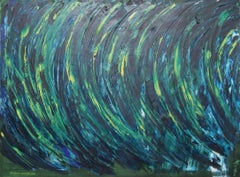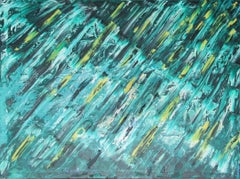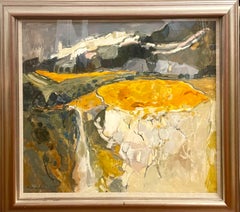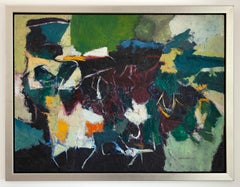Stefan Matty Vladescu Paintings
to
1
2
Overall Width
to
Overall Height
to
2
2
2
2
2
5
781
720
711
697
2
Artist: Stefan Matty Vladescu
String Symphony, Abstract Expressionist Oil Painting by Stefan Vladescu
By Stefan Matty Vladescu
Located in Long Island City, NY
Artist: Stefan Vladescu, Romanian (1952 - )
Title: String Symphony
Year: 2006
Medium: Oil on Canvas, signed and dated
Size: 36 x 48 inches
Category
Early 2000s Abstract Expressionist Stefan Matty Vladescu Paintings
Materials
Oil
The Future of Time, Abstract Expressionist Oil Painting by Stefan Vladescu
By Stefan Matty Vladescu
Located in Long Island City, NY
Artist: Stefan Vladescu
Title: The Future of Time
Year: 2006
Medium: Oil on Canvas, signed and dated
Size: 36 x 48 inches
Category
Early 2000s Abstract Expressionist Stefan Matty Vladescu Paintings
Materials
Oil
Related Items
Sunflowers of Provence, Abstract Expression 20th C/early 21st C Scottish
Located in Hillsborough, NC
Abstract expression of the Sunflowers in Provence sets the traditional fields ablaze with orange. Painted by Scottish artist Sheila McNab MacMillan, who is known for bold outlines of...
Category
Late 20th Century Abstract Expressionist Stefan Matty Vladescu Paintings
Materials
Canvas, Oil
$2,520 Sale Price
30% Off
H 27 in W 30 in D 1 in
Edge
Located in Austin, TX
Waterline Fine Art, Austin, TX is pleased to present the following work:
Oil on board. Signed and dated lower right and verso, titled verso.
36.25 x 48 in.
40.5 x 52.25 in. (framed)
Framed in contemporary silver, tiered floater frame.
Dennis Eugene Norman Burton was a Canadian modernist who was born in Lethbridge, Ontario. He attended the Ontario College of Art from 1952 to 1956, and worked for the Canadian Broadcasting Corporation (CBC) as a graphic designer until 1960.
Inspired by a 1955 exhibition of the “Painters Eleven” at Toronto’s Hart House, as well as American Abstract Expressionist artists such as Robert Motherwell, Jack Tworkov, and Willem de Kooning, Burton shifted his focus toward abstraction in the mid-1950s.
Burton showed with the famed Isaacs Gallery in Toronto, becoming one of the youngest members on the gallery’s roster. A talented musician, he also played saxophone in the Artist’s Jazz Band in Toronto - a pioneering Canadian free-jazz group...
Category
1950s Abstract Expressionist Stefan Matty Vladescu Paintings
Materials
Masonite, Oil, Board
Joy Bomb Triptych, Colorful Abstract Landscape, Oil on Boards Ready to Hang
By Alex K. Mason
Located in Versailles, KY
Three colorful oil paintings on finished boards and ready to hang by Alex K. Mason. Lush foliage, vivid sky, bees circling flowers "Joy Bomb Tripytch" is painted in vivid pinks, blu...
Category
2010s Abstract Expressionist Stefan Matty Vladescu Paintings
Materials
Oil, Board
$5,625
H 24 in W 54 in D 1.5 in
Untitled
By John Opper
Located in Austin, TX
Waterline Fine Art, Austin, TX is pleased to present the following work:
Oil on canvas. Signed lower right, signed and dated verso.
62.25 x 56.25 in.
64 x 58 in. (framed)
Custom framed in a natural cherry wood floater.
Provenance
Washburn Gallery, New York
Behnke Doherty Gallery, Washington Depot, CT
Born in 1908 in Chicago, John Opper moved with his family to Cleveland, Ohio, in 1916. In high school, he began studying art and attending classes at the Cleveland Museum of Art.
After graduation, he enrolled in the Cleveland School of Art (now Cleveland Institute of Art), only to withdraw after a year and move to Chicago, where he took classes at the Art Institute of Chicago. He eventually returned to Cleveland, enrolling at Western Reserve University (now Case Western Reserve), receiving his bachelor’s degree in 1931. The Depression has taken hold during this period, so Opper found work by teaching metalworking and sketching classes at the Karamu Settlement House, the oldest African American theater in the United States.
In 1933, Opper traveled to Gloucester, Massachusetts, eventually connecting with the artist Hans Hofmann, who was teaching at the school run by Ernest Thurn. Hofmann encouraged Opper to work “in a more modern vein and start finding what it’s all about.” Heeding this advice, Opper relocated to New York, co-founding a mail-order club of American and British prints for dissemination to schools and museums.
By the mid-1930s, he joined the Works Progress Administration (WPA) Easel Division, and also began attending the 57th Street school that Hans Hofmann had established after leaving the Art Students League. Looking back at his time at the school, Opper felt that beyond Hofmann’s teaching, most advantageous was his contact with fellow artists, including Byron Browne, Rosalind Bengelsdorf, and George McNeil. At the time, he also met Giorgio Cavallon and the sculptor Wilfrid Zogbaum.
In 1936, Opper became a founding member of the American Abstract Artists, along with Balcomb and Gertrude Greene. The organization was formed to provide an opportunity for artists to show abstract works at a time when such opportunities were scarce. This led to his first solo show in 1937 at the Artists’ Gallery in New York.
During his summer in Gloucester in 1933, Opper came to know Milton Avery. Painting in Avery’s informal studio in New York City the following winter, he became acquainted with Adolph Gottlieb and Mark Rothko. Opper participated in a couple of shows during the 1930s of the American Artists Congress Against War and Fascism, whose president was Stuart Davis. About the same period, Opper joined the Artists’ Union and served as the business manager of its publication, Art Front.
During World War II, Opper worked for a ship design company creating drawings for piping systems used in PT boats...
Category
1950s Abstract Expressionist Stefan Matty Vladescu Paintings
Materials
Canvas, Oil
Untitled
Located in Austin, TX
Waterline Fine Art, Austin, TX is pleased to present the following work:
Oil on canvas. Signed verso. Some scratched out, illegible writing in paint and graphite verso, which may ha...
Category
1960s Abstract Expressionist Stefan Matty Vladescu Paintings
Materials
Canvas, Oil
Untitled
By Michael Goldberg
Located in Austin, TX
Waterline Fine Art, Austin, TX is pleased to present the following work:
Oil, pastel, and paper collage on canvas. Signed and dated verso.
52.75 x 47.75 in.
54 x 49 in. (framed)
Gilded floater frame.
Provenance
Compass Rose, Chicago
Born Sylvan Irwin Goldberg in 1924 and raised in the Bronx, Michael Goldberg was an important figure in American Abstract Expressionism, who began taking art classes at the Art Students League in 1938. A gifted student, Goldberg finished high school at the age of 14 and enrolled in City College. He soon found New York’s jazz scene to be a more compelling environment, and he began skipping classes in favor of the Harlem jazz clubs near campus. Goldberg’s love of jazz would become a lifelong passion and a key component to his approach to composition in his paintings.
From 1940 to 1942, like many of the leading artists of the New York School, Goldberg studied with Hans Hofmann. In 1943, he put his pursuit of painting on hold and enlisted in the U.S. Army. Serving in North Africa, Burma, and India, Goldberg received a Purple Heart and a Bronze Star before being discharged in 1946. After his service, he traveled and worked in Venezuela before returning to the United States, settling back in New York and resuming studies with Hofmann and at the Art Students League.
Living downtown and frequenting the Cedar Bar, Goldberg befriended many of the artists of the New York School. In 1951, his work was included in the groundbreaking Ninth Street Show, co-organized by Leo Castelli, Conrad Marca-Relli, and the Eighth Street Club, and featuring the work of - among others - Hofmann, Jackson Pollock, Willem de Kooning, and Franz Kline. In 1953, the Tibor de Nagy...
Category
1980s Abstract Expressionist Stefan Matty Vladescu Paintings
Materials
Canvas, Pastel, Mixed Media, Oil, Handmade Paper
April 10, 1961
Located in Austin, TX
Waterline Fine Art, Austin, TX is pleased to present the following work:
Oil on canvas. Signed and dated lower right; signed, titled, dated verso.
48 x 60 in.
49.75 x 61.75 in. (framed)
Custom framed in a solid maple floater, with an heirloom white finish.
Provenance
Kootz Gallery, New York
Collection of John G. and Kimiko Powers, New York/Aspen, CO
Prentice-Hall Corporate Art Collection, New York
Kyle Morris was born in Des Moines, IA in 1918. After serving in the U.S. Air Force during World War II, he completed M.F.A. programs at both Northwestern and Cranbrook Academy of Art before settling in New York and renting a studio on Mercer Street in downtown Manhattan during the 1950s. Transitioning away from the figurative painting of his formal training, he began to create the bold gestural works that would serve as his hallmark in the ever-growing fraternity of the New York School.
Morris’ first major solo exhibition occurred at the Walker Art Center in Minneapolis in 1952. This show served as the catalyst for his recruitment onto the rosters of the prominent Stable and Kootz galleries in New York. In 1961, he was included in the Guggenheim’s landmark exhibition, American Abstract Expressionists and Imagists, which surveyed the abstract expressionist movement that would come to dominate contemporary American art...
Category
1960s Abstract Expressionist Stefan Matty Vladescu Paintings
Materials
Canvas, Oil
Parallel Construction
By Oonju Chun
Located in Salt Lake City, UT
Parallel Construction, oil on canvas, 48 x 54 in.
Oonju Chun’s large abstract expressionist paintings delightfully employ the basics of good, nonobjective ...
Category
2010s Abstract Expressionist Stefan Matty Vladescu Paintings
Materials
Canvas, Oil
Untitled
By Paul Brach
Located in Austin, TX
Waterline Fine Art, Austin, TX is pleased to present the following work:
Oil on canvas. Signed and dated lower right.
41.75 x 61 in.
44 x 63 in. (framed)
Custom framed in a hardwo...
Category
1950s Abstract Expressionist Stefan Matty Vladescu Paintings
Materials
Canvas, Oil
Euphoria In Bloom, Contemporary Gestural Abstract Painting
Located in Philadelphia, PA
This painting is a bold and expressive abstract composition created with a combination of oil and acrylic on canvas. It gives off vibrant energy, primarily featuring a palette of pas...
Category
2010s Abstract Expressionist Stefan Matty Vladescu Paintings
Materials
Oil, Acrylic
$4,900
H 48 in W 40 in D 1.5 in
Why The Long Face
By Mark Wilson
Located in Brooklyn, NY
Why The Long Face is an artistic collaboration by painters Mark Wilson and Paola Zarate where they painted simultaneously, often finishing each other's brushstrokes. The piece challe...
Category
21st Century and Contemporary Abstract Expressionist Stefan Matty Vladescu Paintings
Materials
Canvas, Oil Pastel, Oil, Spray Paint, Acrylic
Untitled. Gestural Abstraction, Purple, Oil painting, Polish artist
By Piotr Butkiewicz
Located in Warsaw, PL
Contemporary purple abstract oil on canvas painting by Polish artist Piotr Butkiewicz. Composition consists of dynamic shapes. Painting is untitled. Artwork is signed on the back.
...
Category
2010s Abstract Expressionist Stefan Matty Vladescu Paintings
Materials
Canvas, Oil
$2,934
H 39.38 in W 55.12 in
Stefan Matty Vladescu paintings for sale on 1stDibs.
Find a wide variety of authentic Stefan Matty Vladescu paintings available for sale on 1stDibs. If you’re browsing the collection of paintings to introduce a pop of color in a neutral corner of your living room or bedroom, you can find work that includes elements of blue and other colors. You can also browse by medium to find art by Stefan Matty Vladescu in oil paint, paint and more. Much of the original work by this artist or collective was created during the 21st century and contemporary and is mostly associated with the abstract style. Not every interior allows for large Stefan Matty Vladescu paintings, so small editions measuring 48 inches across are available. Customers who are interested in this artist might also find the work of Christopher Engel, Rostom, and Anya Spielman. Stefan Matty Vladescu paintings prices can differ depending upon medium, time period and other attributes. On 1stDibs, the price for these items starts at $4,500 and tops out at $4,500, while the average work can sell for $4,500.



